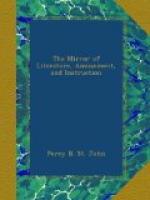at the door of the chamber where the King was, with
Tomlinson, the Bishop, Herbert, and some of his guards.
Herbert and the Bishop were deeply affected at this
signal for their final separation from their sovereign
and master. The King stretched out his hand to
them, which they kissed, falling on their knees and
weeping, the King helping the aged bishop to rise.
He then bade Hacker to open the door and he would follow;
and he was conducted by Hacker, Tomlinson, and other
officers and soldiers, through the banquetting house
by a passage broken through the wall, where the centre
window now is. The street now called Parliament
Street was at that time crossed by two ranges of buildings
belonging to the palace of Whitehall, with wide arched
gateways crossing the street, and forming the public
thoroughfare. One gateway was opposite to Privy
Gardens; and there was a way over it from these gardens
belonging to the palace, to pass into St. James’s
Park. The other building traversing the street
was the sumptuous gallery of Whitehall, built by Henry
VIII., the scene of so many adventures and events
of various descriptions in the reigns of Elizabeth,
James, and the two Charles’s. Connected
with this gallery was “a beautiful gatehouse,”
over a noble archway. Lord Leicester says, in
his Journal (p. 60.),—“The scaffold
was erected between Whitehall gate and the gallery
leading to St. James’s.” Lilly asserts,
that it was just at the spot where the blood of a citizen
had been shed at the commencement of the rebellion,
when a mob were vociferating “
No Bishop”
under the windows of the palace, and some cavaliers
sallied out to disperse them, and one was killed.
A strong guard of several regiments of horse and foot
being posted about the scaffold, so that the people
could not approach near enough to hear any discourse
from the King, he addressed his last sentences chiefly
to the Bishop, Colonel Tomlinson, and the other officers
who stood near him.
[6] See the evidence on the
trials of Hacker, Axtell, and Hulet,
State Trials, vol. v.
“The Bishop. Though your Majesty’s
affections may be very well known as to religion;
yet it may be expected that you should say something
thereof for the world’s satisfaction.”
“The King. I thank you heartily, my Lord,
for that I had almost forgotten it. In troth,
Sirs, my conscience in religion, I think, is very
well known to all the world; and therefore I declare
before you all that I die a Christian, according to
the profession of the Church of England, as I found
it left me by my father; and this honest man, I think,
will witness it.”
Then to Colonel Hacker he said, “Take care that
they do not put me to pain: and, Sir, this and
it please you—”
But a gentleman coming near the axe, the King said,
“Take heed of the axe, pray take heed of the
axe.”
Then speaking unto the executioner, he said, “I
shall say but very short prayers, and when I thrust
out my hands—”




